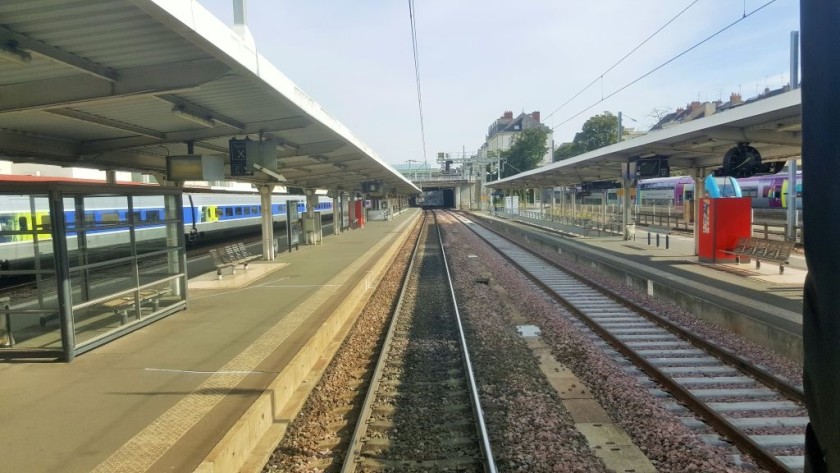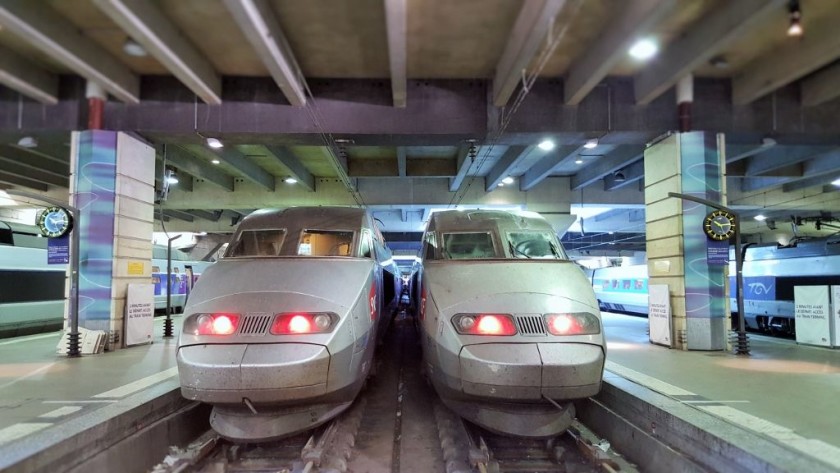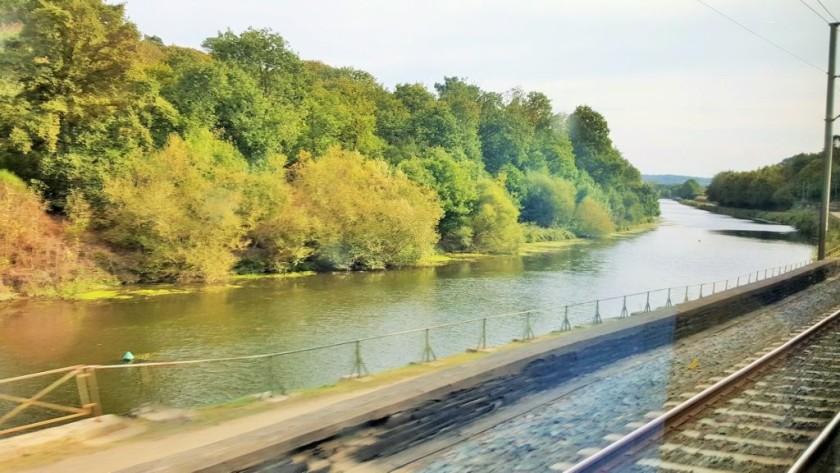Related Content
Content

Paris Montparnasse (Paris)
This guide to Paris Montparnasse train station explains what to look out for when departing and arriving here by train.
Share
At a Glance
Services
Left Luggage
Travel Information Desk
First Class Lounge
Local Tourism Information
Onward Travel
Metro
Car Hire
Taxi Rank
Accessibility
Step Free
Misc
Terminus Station
Helpful Links
Train service summary
The following train services depart from and and arrive at the Gare Montparnasse:
- TGV InOui trains to / from Agen, Angers, Bayonne, Biarritz, Bordeaux, Brest, Hendaye, La Rochelle, Lorient, Le Mans, Lourdes, Morlaix, Nantes, Poitiers, Quimper, Rennes, St Malo, St Nazarre, Tarbes, Toulouse and Tours
- Ouigo Grande Vitesse trains to / from Angers, Bordeaux, La Rochelle, Le Mans, Lorient, Nantes, Poitiers, Quimper, Rennes and Toulouse
- TER trains to / from Chartres, Granville, Le Mans and Versaille-Chantiers
- Transilien trains to / from Versaille-Chantiers
Detailed journey guides for travel to many of these destinations can be accessed from the 'Contents Menu'.






There’s no doubting that taking a train from Paris Montparnasse station can be an unexpected experience.
In contrast to the other mainline stations in Paris, that have all preserved their 19th century character, Paris Montparnasse train station is a fine example of 1970’s brutalist architecture.
So depending on your point of view it’s either monumentally ugly, or admirable in its own way.
What first time users will find particularly odd is that trains depart from an upper concourse, which is above street level, four storeys above the Metro station.
But don’t be alarmed, impressive banks of escalators give access to/from the trains, and lifts are also available which connect all the levels
Good to know
Montparnasse is a station on multiple levels:
- -1 = the metro station
- 0 = street level
- 1 = the main access to/from the local Transillien trains; Hall 4
- 2 = a mezzanine level in the mall at in the front of the station
- 3 = the main access to the long-distance 'Grandes Lignes' trains; Halls 1 and 3
- 4 = the main car access for pick up and drop off by taxi; Hall 2
Though note that ShowMeTheJourney has added the numbers of these levels in an attempt to make sense of the space - when navigating Gare Montparnasse, you won't see signs with the equivalent of Level 1 or Level 2 etc, instead there are signs pointing the way to Hall 1 and Hall 4 etc.
This sounds more complicated than it is in reality.
The space in the front of the building, between the street / metro and the trains, has been converted into a smart mall - and cleverly the opportunity has been taken to make the station easier to navigate.
Plus more escalators and lifts have been incorporated and the signage has been improved - the transfer between the Metro station and the TGV trains, has been particularly transformed for the better!
The four concourses:
The Gare Montparnasse is very large station, it has 28 voies (platforms / tracks) all encased within a massive development of offices - from the street there is no sense that it houses a railway.
Due to its size the station has four concourses which provide the access to and from the trains.
At face value the fact that Gare Montarpansse has four concourses seems confusing, but I have used the station on multiple occasions without even realizing that Halls 2, 3 and 4 exist.
That's because each of the four concourses / halls have different functions, as described below - and I have only ever transferred between the Metro and TGV InOui trains, so the only part of the station I have used is Hall 1.
Hall 1
Hall 1 is the main concourse and it provides the access to and from most of the TGV trains which depart from and arrive at Montparnasse.
It is on the top level of the building, pictured at the top of the page, which fronts on to the pedestrian square around the Tour Montparnasse skyscraper.
It can be accessed by multiple sets of escalators and less obvious lifts / elevators - if you'll want to use a lift, look out for the signs as they can be a tad hidden.
Hall 2

Hall 2 is in the middle of the office complex which houses the Gare Montparnasse so it's located above the midway point of voies (platforms / tracks) 1 - 24.
Though it gives access to all of the trains, as there is a route from Hall 2 to Hall 3, which is the primary access point for voies (platforms / tracks) 25 - 28.
The primary function of Hall 2 is to provide access between the trains and those who will be heading to and from the station by car - hence it being the location of the taxi rank and drop off area.
It has hard to spot pedestrian access on the the street named Pl. des Cinq Martyrs du Lycée Buffon - note that on Google Maps the pin for the location of Hall 2 has been dropped in the wrong place.
Hall 1, which is the main concourse, is linked to Hall 2 by a travellator, which as you face the trains in Hall 1 is on the right-hand side, by voie 24.
Hall 3

Voies (platforms/tracks) 25 - 28 are on the western side of the station, but they are shorter, which is why they are further away from Hall 1.
They in effect begin half way down the length of the building, hence they have their own concourse and entrance hall which is accessed from Rue du Cotentin.
This is Hall 3 and it is also know as Gare Montparnasse Hall 3 and Montparnasse 3 Vaugirard - The idea being that if a train is shown on timetables as departing from Montparnasse 3 Vaugirard, travellers will know that they they can enter directly into this part of Gare Montaparnasse.
It's entrance is in a distinct neighbourhood more than a five minute walk from the Tour Montparnasse.
It is linked to Hall 1 by a travellator and is a short walk from Hall 2, so all of the trains which depart from the Gare Montparnasse can be accessed from Hall 3.
Hall 4

Transilien is the brand name given to the network of local / commuter railways which link central Paris to the city's more distant suburbs and surrounding towns, beyond the reach of the Metro and RER trains.
The Transilien lines / routes which use Montparnasse are the N network and these trains typically depart from voies (platforms / tracks) 11 - 16.
So that the passengers taking these shorter distance trains don't get in the way of those departing on the longer-distance, TGV-InOui, TER and Ouigo services, these Transilien trains are accessed through the departure Hall 4.
Though these voies (platforms / tracks) 11 - 16, which the Transilien trains typically depart from, can also be accessed from Halls 1 and 2.
Book Accommodation
When planning a trip, finding convenient accommodation can be trickier than working out which train to take.
Hence ShowMeTheJourney has partnered with the innovative accommodation portal, Stay 22, to offer three options for discovering your optimum accommodation:
1: Use the map above to see which hotel rooms and Vrbo rentals, with easy access to Gare Montparnasse, are available.
2: Or click on these cherry-picked properties, offered by Stay 22 partner Booking.com, which are by Gare Montparnasse and have been selected on the basis of high guest ratings:
Hôtel Mercure Paris Centre Gare Montparnasse
3: Or see what's available with Stay 22's accommodation partners; which include, Expedia, Hotels.com and Trivago - by clicking the large button below.
Stay 22 will 'shuffle' the booking services so that you can be automatically directed to its partner that currently has the optimum availability at this location.
Questions Answered
ShowMeTheJourney has anticipated what questions are most often asked about taking trains to and from Paris-Montparnasse and answered them below.
If you can't find the information you are seeking, you can ask a question and the AI enabled service will try to write an answer, telling you what you wish to know.
Is there step-free access to and from the platforms /tracks?

Yes, despite the voies (platforms / tracks) being on multiple levels, the station is equipped with multiple escalators and lifts / elevators.
How to travel between the Gare Montparnasse and the city centre
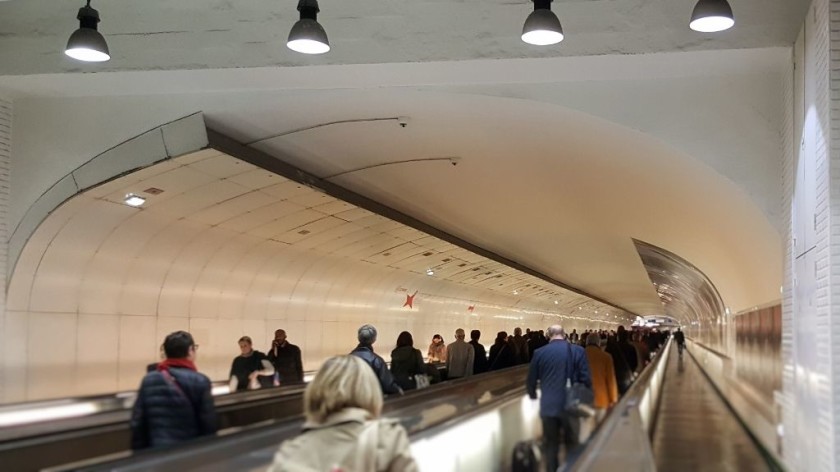

The Montparnasse is served by four Metro lines;
Though in effect there are two Metro stations which share the name of Montparnasse - Bienvenüe
(1) The platforms used by lines 6 and 13 are beneath the main building at the front of Gare Montparnasse, the same building which houses the departure Halls 1 and 4 - see above
(2) A long travellator, pictured above, links this entrance by lines 6 and 13, to the entrance hall which gives the access to lines 4 and 12 - which has its own street entrance around 200 metres from the rail station.
So the transfer between train and Metro is much easier if you can take lines 6 or 13 to or from the Gare Montparnasse - though inevitably some parts of the city centre can be more easily accessed on lines 4 and 12.
To the most popular tourist attractions
- to Notre Dame at Cité station
- to the Pompidou Centre from Étienne Marcel station
- to the Eiffel Tower at Bir-Hakeim station
- to the Arc De Triomphe and the western end of the Champs-Élysées at Charles de Gaulle – Étoile station
- to the Musée D'Orsay from Solférino station
- to the Sacre Coeur and Montmartre from Abbesses station
- to Champs-Élysées and the Place de la Concorde at Champs-Élysées - Clemenceau station
Connect at Champs-Élysées - Clemenceau for line 1 to Palais Royal - Musée du Louvre station.
How to travel between the Gare Montparnasse and Paris Airports
The line 6 of the Paris Metro links Gare Montparnasse to a station named Denfert-Rochereau, where an interchange is available with RER line B - though making the transfer is not step-free,
Both Charles-De-Gaulle airport and Orly airport are served by line B of the RER.
Though the link to and from Orly is indirect, as a people mover system named Orlyval links the airport terminals with Antony station.
More info is available on the guide to airport rail links in France.
How to travel from the Gare Montparnasse to sports and exhibition venues
How to travel on to the major sports, entertainment and business venues across Paris from Montparnasse station:
To the Stade De France
The Stade De France is located more than 3km from the city centre.
Three railway stations serve the stadium:
1 - Stade De France – Saint Denis station
2 - La Plaine Stade de France station
3 - Saint Denis-Porte De Paris station
Though which of them will be the most convenient will depend on the starting point of your journey and where you will be sitting.
If your seats are in blocks are on the south and east sides of the stadium = Blocks A, R, S, T, U, X, Y and Z, the station named La Plaine Stade de France on RER line B has the shortest walking distance of around 10 to 15 minutes.
Take Metro line 6 to Denfert Rocherau and transfer there to a Line B train to La Plaine Stade de France station.
If you will be sitting on the western side of the stadium = Blocks, K, L and N, the shortest and easiest walking route is from the station named Stade De France – Saint Denis on RER line D, despite it being the farthest of the three stations from the stadium.
Though bus line/route 353 is a five stop ride to the stadium and its stop is by blocks U, X and Y.
Take Metro line 6 to Denfert Rocherau and transfer there to a Line B train to the Gare Du Nord and make another transfer there to a Line D train.
On the northern side of the stadium = blocks C, D, E. G, H and J, the Metro stop named Saint Denis-Porte De Paris is closest - it is actually the nearest of the three stations to the stadium.
Take Metro Line 13 direct to Saint Denis-Porte De Paris.
To the Accor / Bercy Arena
The Accor Arena is located within a 20 minute walk of the Gare de Lyon.
Take Metro Line 6 direct to Bercy metro station.
To the Villepinte Exhibition Centre
The Villepinte Exhibition Centre is located on the northern edge of Paris by CDG Airport.rt.
Take Metro line 6 to Denfert Rocherau and transfer there to a Line B train to Parc des Expositions station
To the Addidas / Porte de la Chapelle Arena
The Addidas Arena is located within easy distance of the Porte de la Chapelle metro station, from which it takes its name.
Go direct on Metro line 12 to Port de la Chapelle station
To the Stade Garros
Reaching the iconic tennis venue is a two-step journey:
- take Metro line 6 to La Motte - Picquet Grenelle station
- Transfer to Metro line 10 and leave it at Porte d’Auteuil station
To the Paris Expo Exhibition centre
The Paris Expo Exhibition Centre is located in the south west corner of the city.
Go direct on Metro line 12 to Porte de Versaille station
To the Parc de Princes and the Stade Jean-Bouin
The Parc de Princes and the Stade Jean-Bouin are adjacent to each other in the Boulogne-Billancourt area of the city.
It is a two step journey:
- take Metro line 6 to La Motte - Picquet Grenelle station
- Transfer to Metro line 10 and leave it at Porte d’Auteuil station
How can tickets purchased for the public transport connections?
The excellent parisbytrain website has all the info you will need about metro tickets.
Though the key thing worth knowing is that Paris has pretty much transitioned to a Pay As You Go system for its public transport network, based on navigo cards.
There are two core methods of using navigo:
1 - A plastic card which is automatically issued by ticket machines and ticket counters when you inform the machines or staff, that you don't already have a card - the cost of the card is €2.
2. Downloading the navigo app to a mobile device - the big plus of the mobile app is that you can then use mobile banking to pay for tickets to be added to it, so can then avoid the ticket machines and counters!
You can load the cards or app with journeys or passes and then tap the card or mobile device on the ticket gates.
Are there cafes or restaurants available?
There are two restaurants at the station, the Dépôt Légal (though it makes no mention of its Gare Montparnasse location on its website?) and a branch of the Italian restaurant chain, IT Trattoria.
There are also numerous snack, sandwich and fast-food outlets.
Are there left luggage facilities?
The left luggage office the 'Consignes', is by the Hall 1 concourse -when facing the trains it is on the far right by the entrance to voie (platform / track) 24.
Thee access to the lockers is staffed, so you can only deposit and collect luggage when it is open - and its typical opening hours are 07:00 to 22:00 daily.
Does the station have a First Class lounge?
Yes, the station has a Grand Voyageur lounge, which can be accessed by those who will be travelling with Business Premiere tickets, on the TGV InOui services.
Departing by long-distance train:
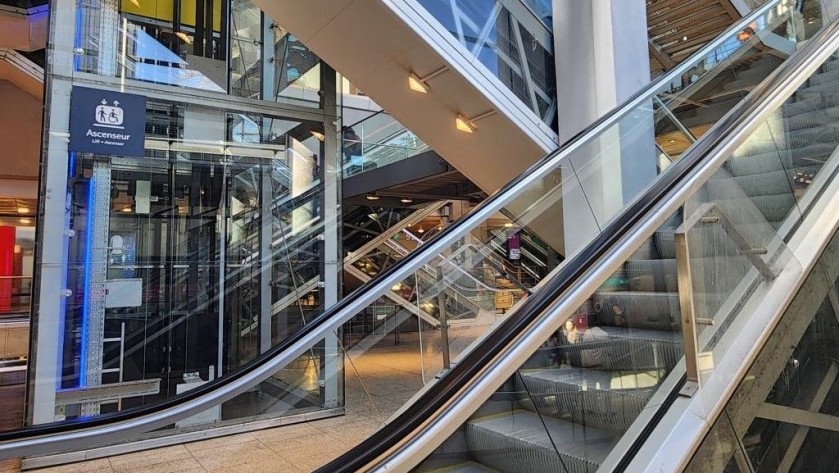
If you are taking a TGV (InOui or Ouigo) service from Montparnase then when you enter the station building follow the signs pointing the way to the ‘Grandes Lignes’.
If you have entered the station at street level at the front of the building, or have arrived by Metro, you will need to ascend to the levels above, up to the Hall 1 area of Montparnasse train station used by the TGVs and other long distance trains.
If you arrive by taxi you will likely be dropped off by the entrance to a separate part of the station, Hall 2, which is above the trains.
The specific voie (platform/track) that a train will depart from, isn’t usually confirmed until 10–20 mins before departure.
So keep an eye on the departure monitors or the departure board, which dominates the main concourse.
Announcements re: departures are only made in French.
If you can’t see the station that you’re travelling to on the departure screens - find your train using the train number.
This will be a 4 digit number, which will be printed on your ticket - so match the number to the train number that will be on the departure screens.
Transferring from the Metro:

The Metro station at Montparnasse is named 'Montparnasse – Bienvenüe' - but it is very much a station of two parts.
The part of the Metro station used by lines 4 and 12 is much further from the mainline station, Gare Montparnasse, than the part of the Metro station used by lines 6 and 13.
Line 4 links the Gare Du Nord to Montparnasse and or guide to making this transfer between the stations is HERE.
Allow 10-15 mins between stepping off a Metro Line 4 and 12 train to boarding a TGV, or a minimum of 5 - 7 mins if you arrive on Metro Lines 6 or 13.
On exiting the metro, a ramp and stairs are available for a transfer to the escalators and elevators, which provide step-free access to Hall 1 for long-distance departures.

Once you're at the top of the escalator, or step out of a lift, you can head over the mall area into Hall 1 to await an onward departure.


Or if you have time to await a departure, you can take a different path within the station and make the most of a mall area which also houses some restaurants and other food / drink outlets.
Boarding from Hall 1


Despite the fact that everyone who will be taking a TGV has a reserved seat, the confirmation of the voie (platform/track) number usually prompts a stampede towards the train.
Join the throng if you have luggage - space on TGV luggage racks can be limited.
But if you don’t have luggage there's no need to rush, the less stressful option is to hang back and wait until those that do have luggage etc, have stowed their bags and taken their seats.
Though TGV Atlantique trains - which for the time being form a few of the long distance (Grandes Lignes) departures from Montparnasse, can be 20 carriages/coaches long.
Two 8 or 10 coach trains can be joined together, so be prepared to trek down the platform to the carriage/coach in which your seat is located - and give yourself time to do so.
Something to watch out for is that a condition of French train tickets, is that you must be on the platform to board your train a minimum of 2 minutes before the train departs.
Barriers are being installed at Montparnasse to enforce this rule, they’re closed around 2 minutes before departure!
Boarding from Hall 2

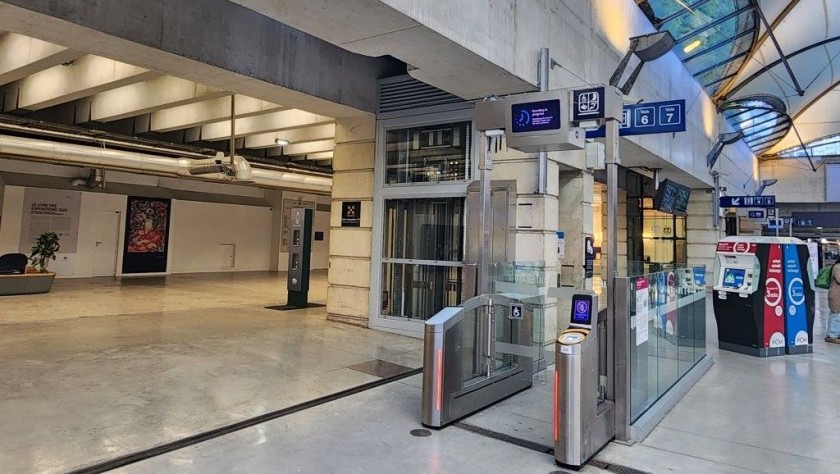
If you arrive by car you will enter into Hall 2, which is a quiet location to await a departure.
A smart waiting room is available to all passengers, but if you arrive more than 45 mins pre-departure and therefore want to make the most of the retail and dining opportunities at Montparnasse, youll need to head over to the area of the station in front of Hall 1.
It can be accessed in around three minutes and the clearly signposted route involves taking an escalator and a moving walkway,
departing from Montparnasse 3 Vaugirard:


There is a separate part of the station, often named ‘Montparnasse 3 Vaugirard’, which is where voies (platforms/tracks) 25 - 28 are located;
The access to them from the main station is by travellator to the side of voie 24, which is on the far right of the concourse when facing the trains,
You need to keep going until you come to the entrance to what looks like a separate station, named Gare Montparnasse Hall 3.
From this entrance on voie 24 you need to take an escalator or elevator up to the trains.
Your efforts will be rewarded as this Hall 3 is smart and modern.
When initially entering from the front station, or arriving by Metro, follow the signs up pointing the way to the 'Grandes Lignes' departures until you come to the main concourse, then head along the travelator
At a leisurely pace, from stepping off a line 4 or 12 train to being on the concourse in Hall 3 will take around 10 minutes.
Montparnasse 3 Vaugirard also has a street level entrance, which has step-free access to the trains by escalator and elevator, so if you will be taking a train from here, an option is to take a taxi to this entrance.
This entrance is entirely separate to the main station so the name shown above its doors is 'Gare Vaugirard Montparnasse 3'; it's on Rue du Contentin.
Arriving by train:

Our guide to arriving by train at Gare Montparnasse focuses on how to transfer to the Metro - and then how to use the Metro to reach the other mainline stations.
If you're not used to using Paris Montparnasse then this can be confusing.
Many TGV trains that arrive at Montparnasse can be 20 coaches long, so if your reserved seat is towards the rear of such a train, it can take around 5 mins before you step on to the main concourse at the station.
Though one plus is that the main concourse is on the same level as the voies (platforms/tracks) which the trains will arrive at.
Once you're on the main concourse keep going ahead of you until you are in the Hall 1 area of the station, when arriving by train this Hall 1 is behind the main concourse.
At the rear of Hall 1 you will see banks of escalators which connect this Hall 1 to the street level exits and the entrance to the Metro station.
Lifts / elevators are also available - look out for the signs which point out their less obvious locations.
accessing the Metro:
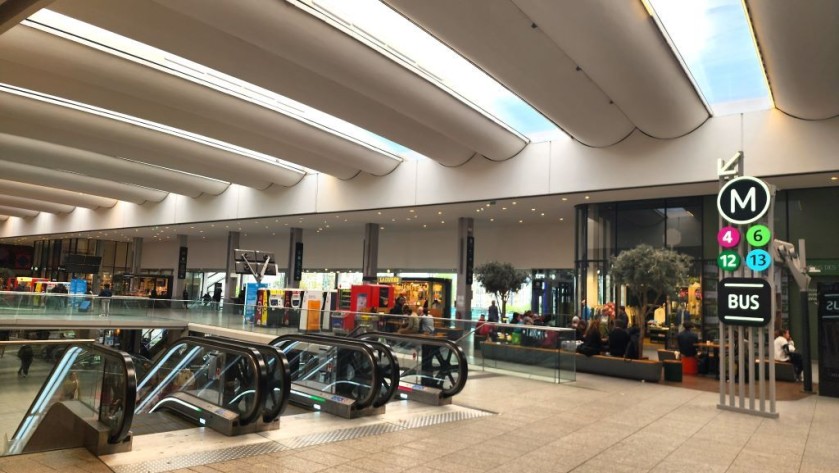

The entrance to the Metro station is located three levels below the area of Montparnasse train station that the long distance express trains arrive at (Hall 1).
There are multiple sets of escalators available, though you may have to seek out an escalator which leads downwards.
Less obvious lifts / elevators are also available and a sloping path leads down to the metro station entrance - though once you are in the metro station, the access to the trains is not step-free.
The Metro station is named 'Montparnasse – Bienvenüe' - and it is very much a station of two parts.
Line 6 and Line 13 use the part of the Metro station closest to its entrance hall.
However, Line 4 and Line 12 are some distance away at the end of an exceptionally long travellator - that can be accessed from the Metro entrance hall
Taking a taxi


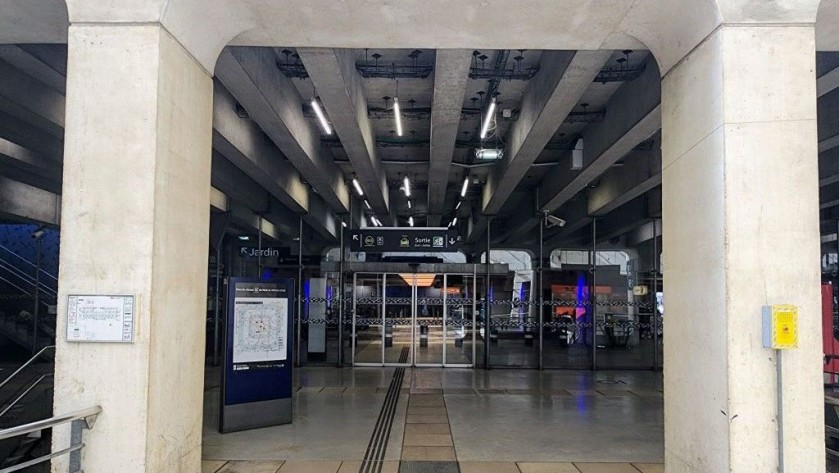
At the mid-point of the voies (platforms/ tracks) 1 - 24, which are the voies at which most of the TGV InOui, TER and Ouigo trains arrive at, you will see signs pointing upwards, directing travellers to the taxi rank.
This is because the taxi rank can be accessed from Hall 2, which is above the trains.
You can access it by escalator and most of the voies also have an elevator link up to it
Note that this access to Hall 2 may be behind you when stepping off a train, so if you want to take a taxi, don't follow the crowd on to the main concourse.
to the Gare Du Nord:
See the guide below.
to Gare de l'Est:
This is a transfer that looks straightforward - as Metro Line 4 provides a direct link between Montparnasse and the Gare de l'Est - direction Porte de Clignancourt.
However, if you have luggage it’s far from convenient – and even if you don’t, it can be energy sapping.
Also line 4 is the 2nd busiest Paris Metro line - so at peak times the crowds can seem overwhelming.
Stage One:
The line 4 platforms/voies at Montparnasse – Bienvenüe metro station, are connected from the Metro entrance hall by long passage ways.
So long, that despite the travellators, it takes 8 - 10 minutes to make the transfer to the Metro platform, from stepping off a main line train at Montparnasse.
You will experience a ‘will I ever get there’ feeling and between the travellator and the Metro platform you'll also have to negotiate stairs - so it's awkward if you have luggage.
Stage Two:
It’s then 13 stops from Montparnasse – Bienvenüe metro to the Gare de l'Est, so the train journey takes 20–25mins.
Stage Three:
When you eventually arrive at Gare de l'Est, follow the signs to ‘Grande Lignes', if you will be taking a TGV, Thalys, Eurostar or Intercités train.
The alternative bus link
In the summer, making the transfer can be particularly uncomfortable, temperatures can soar at both main line stations, on the train and in the passage ways.
So if time is on your side, it can be a good idea to take the bus.
Line 91 goes to the Gare de l'Est from two stops at Montparnasse:
to Gare de Lyon:
This is an awkward transfer- as there are no direct Metro or RER lines between Montparnasse and the Gare De Lyon.
The easiest of many metro journey options is:
(Stage 1) Take a line 6 train to Bercy station - direction Nation.
(Stage 2) At Bercy transfer to a Line 14 train (direction St Lazare) for the one stop hop from there to the Gare De Lyon.
Two reasons why we recommend this routing.
(1) The Line 6 platforms are the nearest to the entrance to the Montparnasse – Bienvenüe metro station
(2) From the Line 14 platforms there are lifts up to the Metro station concourse at the Gare De Lyon.
Or to take the bus.
Line 91 goes to the Gare De Lyon from two stops at Montparnasse; see above.
to St Lazare:
Direct Metro trains on two lines connect Montparnasse to St Lazare.
However, the recommendation is to use Line 13 and take trains heading towards Saint Denis or Asineres and NOT line 12.
The line 13 trains are much easier to access from the Metro station entrance at Gare Montparnasse than the Line 12 trains.
Then at St Lazare, the part of the station complex used by the line 13 trains, also has easier access to the main part of the station than the Line 12 trains.
to Austerlitz:
This is an awkward transfer - as there are no direct Metro or RER lines between Montparnasse and Austerlitz.
The easiest of many options is
(Stage 1) Take a line 6 train to Place d’Italie - direction Nation
(Stage 2) Transfer at Place D'Italie station to a Line 5 train - direction Bobigny
A plus is that the Line 6 platforms are the nearest to the entrance at Montparnasse – Bienvenüe metro station.
A negative is that multiple staircases need to be used when making the transfer between the Metro Lines at Place d’Italie.
Another negative is that Austerlitz Metro station is above ground; and there are no escalators/lifts down to ground level where the mainline trains depart from, you have no choice but to use the stairs.
So taking the bus can be a good alternative
Line 91 goes to Austerlitz from two locations at Montparnasse; see above for the locations.
Though if you have luggage or the weather is hot, a taxi can be worth every cent
Journeys
# Jump to a directionDirections
Journeys from Paris Montparnasse
Jump to directionsParis to Angers by train
Paris to Bayonne by train
Paris to Biarritz by train
Paris to Bordeaux by train
Paris to Futuroscope by train
Paris to Hendaye / Hendaia by train
Paris to La Rochelle by train
Paris to Le Mans by train
Paris to Lourdes by train
Paris to Morlaix by train
Paris to Nantes by train
Paris to Poitiers by train
Paris to Quimper by train
Paris to Rennes by train
Paris to St Malo by train
Paris to Toulouse by train
Paris to Tours by train
This second version of ShowMeTheJourney is exciting and new, so we are genuinely thrilled that you are here and reading this, but we also need your help.
We’re striving not to let anything get in the way of providing the most useful service possible, hence a facility has been set up with DonorBox which can be used to support the running costs and make improvements.
Instead of advertising or paywalls, your financial support will make a positive difference to delivering an enhanced service, as there’s a lot of ideas which we want to make happen.
So if you have found the info provided here to be useful, please consider saying thank you.

This is one of more than 100 train travel guides available on ShowMeTheJourney, which will make it easier to take the train journeys you want or need to make. As always, all images were captured on trips taken by ShowMeTheJourney.






